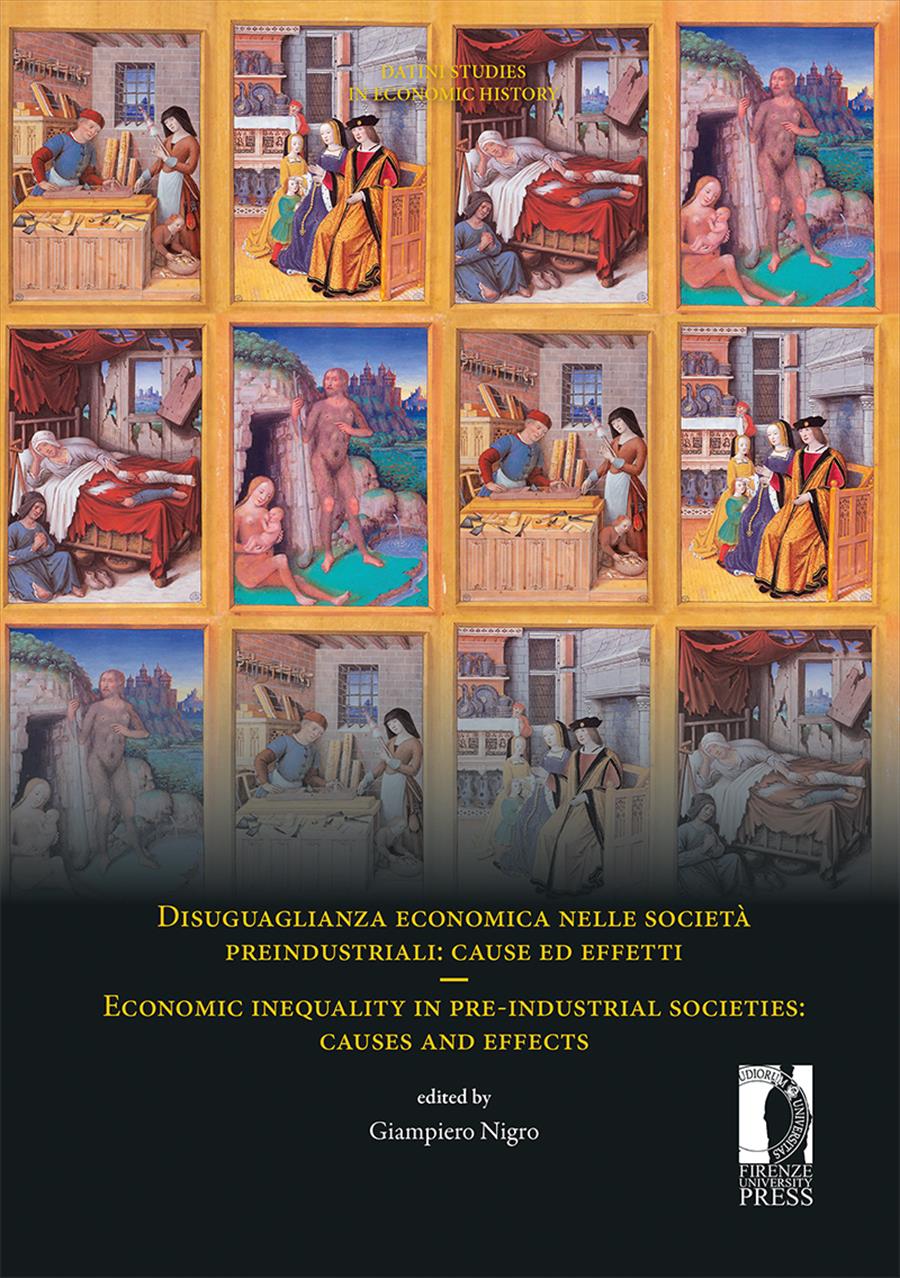Ineguaglianze economiche. Le certezze e le incertezze
- Paolo Malanima
- © 2020 Author(s) |
- CC BY 4.0
- DOI: 10.36253/978-88-5518-053-5.05
The aim of the opening speech is to present the most discussed issues in relation to inequality in personal distribution of income and wealth. In particular, it first examines the current trends in economic inequality (§ 1-4). Overall, some certainty has been achieved on these trends over the last century. In a second part of this opening speech (§ 5-7), some knowledge we have about pre-modern inequalities is summarized. In this regard, uncertainties are much more numerous than certainties.
- Keywords:
- Economic inequality,
- economic history,
- pre-industrial age,
University of Catanzaro Magna Graecia, Italy - ORCID: 0000-0001-9924-6681
- Alfani G. (2017), The rich in historical perspective: evidence for preindustrial Europe (ca. 1300-1800), «Cliometrica», 11: 321.
- Alfani G. (2019), Wealth and income inequality in the long run of history, Diebolt, C. e Haupert, M. (eds), Handbook of Cliometrics, Springer, Berlino-Heidelberg: 1-30.
- Álvarez-Nogal C. and Prados De La Escosura L. (2013), The rise and fall of Spain (1270-1850), «Economic History Review», 66: 1-37.
- Atkinson A.B., Piketty TH. e Saez E. (2020), Top incomes in the long run of history, in Atkinson A.B. e Piketty, TH. (eds), Top incomes. A global perspective, Oxford University Press, Oxford: 679.
- Bloch M. (1973), I caratteri originali della storia rurale francese, Einaudi, Torino [ed. orig. Bloch, M. (1931), Les caractères originaux de l'histoire rurale française, Librairie Armand Colin, Paris].
- Credit Suisse, Global wealth databook 2018, <www.credit-suisse.com> (05/20).
- Credit Suisse, Global wealth report 2018, <www.credit-suisse.com> (05/20).
- Dabla-Norris E., Kochhar K., Ricka F., Suphaphiphat N. e Tsounta E. (2015), Causes and consequences of income inequality: a global perspective, IMF Staff Discussion Note: 6.
- Herlihy, D. and Klapisch-Zuber, C. (1978), Les Toscans et leurs familles. Une étude du catasto florentin de 1427, Éditions de l'Ecole des Hautes Études en Sciences Sociales, Parigi.
- Kuznets S. (1955), Economic growth and income inequality, «American Economic Review», 45: 1-28.
- Lange G-M., Wodon Q. and Carey K. (eds) (2018), The changing wealth of nations 2018. Building a sustainable future, The World Bank, Washington.
- Le Roy Ladurie E. (1969), Les paysans de Languedoc, Flammarion, Paris.
- Lindert P.H. (1982), Revising England’s social tables 1688-1812, «Explorations in Economic History», 19: 385-408.
- Maddison A. (2007), The World economy: historical statistics, OECD, Paris.
- Malanima P. (2000), Crescita e ineguaglianza nell’Europa preindustriale, «Rivista di storia economica», 16: 189-212.
- Milanovic B. (2007), Worlds apart. Measuring international and global inequality, Princeton University Press, Princeton.
- Milanovic B. (2016), Global inequality. A New Approach for the Age of Globalization, Harvard University Press, Cambridge.
- Milanovic B. (2016), Income inequality is cyclical, «Nature», 537: 479-482.
- Milanovic B. (2018), Towards an explanation of inequality in premodern societies: the role of colonies, urbanization, and high population density, «Economic History Review», 71: 10-34.
- Milanovic B., Lindert P.H. and Williamson J.G. (2010), Pre-modern inequality, «Economic Journal», 121: 255-272.
- Morrisson CH. and Murtin F. (2011), Average income inequality between countries (1700-2030), Fondation pour les études et recherches sur le développement international.
- OXFAM (18 January 2016), An economy for the 1%. How privilege and power in the economy drive extreme inequality and how this can be stopped, 210, Oxfam briefing paper.
- OXFAM (gennaio 2019), Ricompensare il lavoro, non la ricchezza.
- Pareto V. (1996), La curva dei redditi, in Una teoria critica della scienza della società, Busino G. (a cura di), Rizzoli, Milano.
- Pareto V. (1996), Una teoria critica della scienza della società, in Busino, G. (a cura di), Rizzoli, Milano: 39-47.
- Pareto V. (2009), Corso di economia politica, in Palomba G. (a cura di), Mondadori, Milano.
- Piketty TH. (2013), Le capital au XXIe siècle, Éditions du Seuil, Paris.
- Van Zanden J.L. (1995), Tracing the beginning of the Kuznets curve: Western Europe during the early modern period, «Economic History Review», 48: 643-664.
- World Bank (2006), Where is the wealth of nations? Measuring capital for the 21st century, The World Bank, Washington.
- World Bank (2018), World Development Indicators, <http://datatopics.worldbank.org/world-development-indicators/> (05/20).
Chapter Information
Chapter Title
Ineguaglianze economiche. Le certezze e le incertezze
Authors
Paolo Malanima
Language
Italian
DOI
10.36253/978-88-5518-053-5.05
Peer Reviewed
Publication Year
2020
Copyright Information
© 2020 Author(s)
Content License
Metadata License
Bibliographic Information
Book Title
Disuguaglianza economica nelle società preindustriali: cause ed effetti / Economic inequality in pre-industrial societies: causes and effect
Editors
Giampiero Nigro
Peer Reviewed
Number of Pages
488
Publication Year
2020
Copyright Information
© 2020 Author(s)
Content License
Metadata License
Publisher Name
Firenze University Press
DOI
10.36253/978-88-5518-053-5
ISBN Print
978-88-5518-052-8
eISBN (pdf)
978-88-5518-053-5
eISBN (xml)
978-88-5518-054-2
Series Title
Datini Studies in Economic History
Series ISSN
2975-1241
Series E-ISSN
2975-1195
